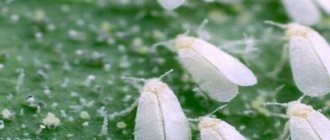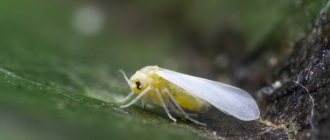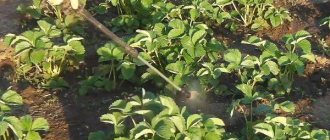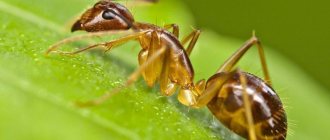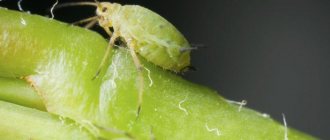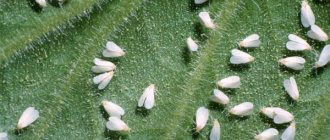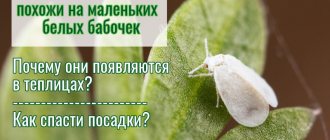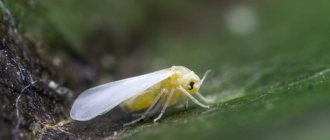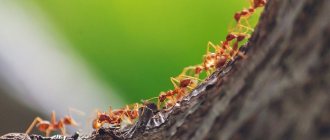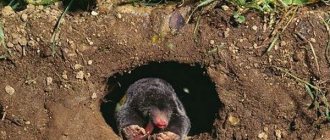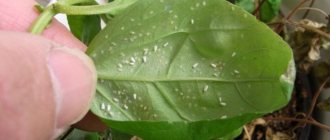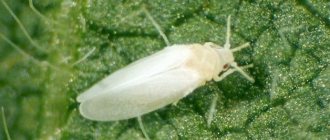Many gardeners who strive to obtain early and long-lasting vegetable harvests are forced to face the problem of how to get rid of whiteflies in a greenhouse on cucumbers and tomatoes. These tiny but numerous insect pests, sucking the juices out of plants and depriving them of vitality, are capable of causing enormous damage and nullifying all human efforts.
Whitefly (pictured) is one of the most common pests of greenhouse crops and indoor plants
There is only one way out of this situation - to comprehensively apply all possible control methods, taking into account the biological characteristics of this insect.
How to get rid of whiteflies on tomatoes in a greenhouse?
Whiteflies love to live in tomato leaves, usually on the bottom.
This is a comfortable place for them to live and reproduce. Residues from their vital activity, whiteflies and their larvae, fall onto the leaves below, causing harm to them as well. The excrement of parasites, containing spores of sooty fungi, eats into the leaves and infects them. Outwardly it looks like this: a white coating appears, after which the affected area turns black. This insect easily moves to neighboring plants using its wings and springy legs, so removal work must be carried out throughout the entire greenhouse. Listed below are chemical and folk remedies for pest control.
How to determine that whitefly has appeared on tomatoes?
You can identify the pest using the following signs:
- whitish, yellow or black spots appear on the leaves;
- shine on the leaves;
- the foliage withers and curls;
- upon contact with a tomato branch, white midges fly into the air;
- Tomato fruits ripen poorly and have white streaks.
When and where does whitefly appear?
Whitefly appears on indoor flowers and garden plants mainly in warm summers with frequent precipitation. Why? Because this midge loves the combination of high temperature and high humidity. Below 10 degrees is a killer temperature for it; all life processes in the whitefly colony stop (while the eggs remain alive and successfully overwinter).
The favorite place of residence of whiteflies, out of season, is greenhouses and greenhouses. Especially those that do not have effective ventilation and the plants are located too close to each other. Therefore, control of whiteflies is possible even before the pest appears. The only thing required is not to provide “resort” living conditions for the whitefly. You should:
- do not thicken plantings;
- do not spray in wet weather;
- strengthen plant health through the use of biostimulants (amulet, houseflower, epin) and fertilizers.
What is the danger of whitefly
In addition to the physical harm of sucking juice, the whitefly carries infections and fungal diseases.
The white midge occupies the entire host plant; adult butterflies, clutches and larvae coexist on one bush.
The overwhelming damage is caused by larvae in the active feeding stage:
- They suck the juices out of the plant, inhibiting its growth activity and immunity.
- Sticky discharge becomes an ideal environment for the development of bacterial and fungal infections.
The waste products of larvae and butterflies contribute to the development of sooty fungus on the plant, which is difficult to treat not only with traditional methods, but also with fungicides. The development of fungus in 80% of cases leads to the death of the plant.
Of the one and a half thousand species of insects of the Aleurodidae family, the greenhouse whitefly poses a particular danger to agricultural crops. The homeland of this harmful moth is South America. This is what explains the special “love” of whiteflies for greenhouses and greenhouses, where a warm and humid climate is maintained.
In one calendar year, the whitefly is capable of producing 15 generations. When the air temperature drops to 10-12 degrees, the pest’s ability to reproduce decreases, but the butterfly calmly waits out the cold weather in the top layer of soil or in plant debris.
The complete transformation of the pest from an egg into a mature individual occurs in 25-40 days. The more favorable the conditions for the butterfly’s existence—humid air and room temperature—the faster the whitefly “ripes.” The life cycle of the whitefly consists of four “ages”, during each of which the butterfly causes harm to garden and vegetable crops.
- Tramp larva - hatches 11-12 days after laying eggs. The size is 0.25-0.3 mm, intensively spreads over the surface of the leaves in search of the most favorable habitat.
- The nymph larva - after 5-6 days, is tightly attached to the underside of the leaves of the plant. Having pierced the leaf, the nymph provides itself with nutrition from the juice of the foliage and remains completely immobile until reaching the next stage of growth. It is difficult to detect visually; it looks like a thin greenish scale. During its existence, it becomes covered with a waxy secretion, which makes it invulnerable to insecticides.
- The pupa is the final stage of whitefly development and lasts from 7 to 30 days.
- Formation of an imago (adult whitefly), ready to devour the plant.
An adult female whitefly lives about 30 days, during which time she can lay up to 140 eggs. For this reason, one greenhouse plant can often become a haven for harmful butterflies at all stages of development - from colonies of eggs to hundreds of adult moths.
How to prevent whiteflies?
Whiteflies appear where high temperatures are combined with high humidity (greenhouses, greenhouses, first of all), there is not enough ventilation, and plants are placed too closely. For this reason, firstly, it is necessary to provide the plant with optimal moisture and temperature conditions and ventilation.
Also, all drugs that strengthen the plant have a preventive effect - a healthy, strong plant will withstand a whitefly invasion with less losses, provided that you still defeat it.
Natural enemies of whiteflies, for example, lacewings and ladybugs, can quickly destroy pests.
Whiteflies on a hibiscus bud. mary wolfe
Prevention measures
You can fight harmful insects all season long, so experienced gardeners prefer to prevent its occurrence by adhering to preventive measures:
- before planting seedlings, it is advisable to paint the greenhouse frame;
- collect all the tops left over from last season and dig up the ground;
- the greenhouse must have good ventilation;
- when disembarking, the air temperature should show about 15 degrees on the thermometer;
- there should be sufficient distance between the bushes;
- You should not leave compost pits open for the winter; whiteflies can easily survive the winter there;
- the greenhouse is disinfected annually with a solution of manganese or copper sulfate;
- In winter, you can open the greenhouse for disinfection at sub-zero temperatures.
When purchasing seedlings at a retail outlet, try to make sure that the plant is not affected by harmful larvae.
Reasons for the appearance of harmful insects in a greenhouse
- contaminated soil or diseased seedlings;
- tomato tops not harvested from last season;
- non-compliance with the ventilation regime;
- close planting of seedlings.
The whitefly goes through three stages of growth, which makes it difficult to control. Insects in all stages of growth can be present in a greenhouse at the same time, so it is better to use several control methods at once.
Mechanical methods
- wiping tomato leaves with a napkin;
- preparing special traps;
- installation of fumigators.
It is forbidden to be in a closed greenhouse with the fumigator plugged in; this causes intoxication of the body.
Biological methods
Attracting insects that are dangerous to whiteflies, but harmless to tomato crops. These insects include:
- lacewing;
- ladybug (coccinellida);
- macrolophus bug;
- pupae of parasitoid wasps.
Chemicals cannot be used at the same time with this method.
Folk remedies
To spray bushes, various infusions are used from:
- tobacco;
- garlic;
- wood ash;
- yarrow;
- dandelion
Chemical methods
- Verticillin - dilute 25 ml of the drug per 1 liter of water, spray 2 times with an interval of a couple of weeks.
- Pegasus - dilute 2 ml per 1 liter of water, spray 2 times, maintaining an interval of a week.
- Confidor - spray 1 time.
- Actellik - one ampoule per 1 liter of water, spray 2 times.
The whitefly easily gets used to the preparations, so it is better to change the preparation the next time you spray. You should not use very poisonous drugs, this is not the best option. Chemicals accumulate on the plant and in the soil, and are absorbed into the fruit, which becomes unfit for consumption. There is a preparation for all stages of development.
When processing tomatoes in a closed greenhouse, it is very important to wear personal protective equipment to avoid contact of chemicals with the skin, eyes or respiratory tract.
How to exterminate a pest
Dry air and heat encourage the spread of pests, making them a common problem in greenhouses during the winter. The fight against this insidious insect cannot be delayed. Immediately after detecting a pest, its destruction should begin. There are enough methods of struggle and methods of protection.
Greenhouse treatment
It is important to choose the right way to treat the greenhouse against whiteflies. Delay is fraught with great negative consequences, since the greenhouse provides good conditions for feeding and reproduction for insects.
The pest can be destroyed by spraying the plantings with a purchased insecticide. To completely eradicate whiteflies on tomatoes and cucumbers in a greenhouse, you will need to carry out 2-3 treatments.
Autumn treatment of a greenhouse against whitefly includes the following list of preventive measures:
- Preparation for disinfection . After harvesting the previous crop, you need to remove plant remains, machinery, and equipment from the greenhouse. Then the soil of the greenhouse is covered with plastic film and disinfection of the internal structures begins. This action point concerns glass, film and polycarbonate greenhouses.
- Disinfection of structures. When carrying out disinfection, they strive to ensure that the disinfectant penetrates into hard-to-reach places in the greenhouse where the whitefly overwinters. The drug uses a chemical that dissolves the cuticle of the pest egg. The following means of control have found widespread use:
- aqueous solution of industrial alcohol;
- creolin solution.
- Repeated disinfection . After waiting 3 days after the first treatment, duplicate disinfection of greenhouse structures is carried out. The drug Aktara is used. They should re-treat the greenhouse structures to kill any midges and nymphs that survive the first treatment.
Attention! Chemical disinfection must be carried out by adult workers wearing personal protective equipment. Work is carried out in the evening.
- Soil disinfection . This butterfly is not able to live in an alkaline environment. Therefore, the soil in the greenhouse should be dug deeply for the winter, with ash or lime first added to it. Lime is added at 150 g per m², ash is added at 3 cups per 1 m². This measure to combat whiteflies in greenhouses is effective and does not require large expenses.
- Fumigation. Smoke bombs equipped with insecticide are used. If you can’t buy checkers, you can use ordinary sulfur. Checkers or baking sheets with sulfur powder are evenly distributed throughout the greenhouse and set on fire. When a bomb is burned, a gaseous insecticide is released, and sulfur, when burned, releases a very toxic gas - sulfuric anhydride. These are very effective means of removing the pest from the greenhouse.
Important! Before starting fumigation, you need to plug the cracks in the greenhouse to prevent gas from escaping outside. After 2 days, the greenhouse should be well ventilated. The products are toxic to humans - safety precautions must be observed.
- Freezing the greenhouse . The whitefly dies in winter from frost. Therefore, freezing can be used as a very effective method to get rid of harmful insects. In winter, when frosty weather sets in, the thermometer will show -15 degrees, the heat supply in the greenhouse or greenhouse is turned off, the doors and vents are opened. Frost will kill butterflies and larvae.
Before planting, seedlings should be inspected for the presence of whiteflies by carefully examining the lower surfaces of the leaves.
Mechanical removal
Before starting chemical insect control, it is worth first finding less invasive methods. The mechanical method is the most simplified, often used in the spring against whiteflies in cucumber plantations, when several insects are found. The following techniques are used:
- manual collection and destruction of butterflies;
- knocking insects off leaves with water;
- wiping the bushes with a water solution of soap.
This method gives temporary results and is of little benefit. It will not be possible to destroy the entire population of midges; insects knocked down by water will again strive to return to their original place.
A simple and quite effective way is to catch adult insects using a vacuum cleaner. This is an effective solution at the beginning of the appearance of insects, when they have not yet laid eggs. Care must be taken to ensure that the suction force of the device does not damage leaves or other plant organs. This procedure is best done early in the morning because the insects are not mobile due to the lower temperature. Before catching whiteflies, the plant should be shaken to encourage it to fly. Adults collected using a vacuum cleaner are destroyed.
Advice. When growing plants, when the number of whiteflies decreases, it is important to remove older leaves on which the larvae sit and lay eggs.
Traps
As a means of combating whiteflies in a greenhouse, purchased and homemade traps are widely used. Yellow traps can be used successfully to monitor the presence of whiteflies and limit their numbers, especially when they first appear. They can be purchased in the form of yellow and orange pieces of thick paper or tape with an adhesive substance applied to the surface. Insects perceive the orange color as a source of light. Butterflies fly towards him, land and stick. Unfortunately, traps are ineffective against larvae and eggs.
Below is how to make a whitefly trap yourself:
- take equal amounts of rosin, castor oil and petroleum jelly melted in a water bath, combine and mix these ingredients;
- add a spoonful of honey;
- cool the mixture;
- apply the composition to pieces of whatman paper;
- We place ready-made devices for catching butterflies among greenhouse plants.
Research has shown that the best traps for greenhouse whiteflies are yellow traps that are additionally illuminated.
Catching whiteflies with yellow traps or using a vacuum cleaner is effective until the adults lay eggs.
Biological method
In its natural habitat, the whitefly has many enemies. The biological method of controlling whiteflies in a greenhouse is based on this. The following methods exist:
- Encarsia formosa and Eretmocerus Eremicus. These are predatory insects that parasitize whitefly eggs. In the greenhouse, predator pupae are evenly distributed in groups of 5. per 1 m². Adult encarsias emerge from the pupae and begin to destroy whiteflies. One female parasite can lay about 200 eggs in eggs and larvae of the third and fourth stages of whitefly development. The effectiveness of E. formosa may be limited by high temperature. In such conditions, an entomophage is recommended Eretmocerus Eremicus. (Eretmocerus eremicus or E. californicus). The advantages of E. eremicus are that it controls both whitefly species even at high temperatures and exhibits higher insecticide resistance than E. formosa. In turn, E. formosa is characterized by a more rapid increase in population size. In this situation, it is recommended to introduce both parasites at the same time, this way the various stages of whitefly development are destroyed. Weekly introduction of natural enemies will effectively reduce whitefly numbers. The frequency of introduction into the crop and their quantity depends on climatic conditions (temperature), plant species and whitefly species. The number of E. eremicus introduced into the greenhouse should be much higher than the number of E. formosa, since half the parasite population is male.
- Mushrooms. In addition to parasites, entomopathogenic fungi are used: Beauveria bassiana, Verticillium lecanii and Paecilomyces fumosoroseus. Fungi have been successfully used to reduce populations. When using P. fumosoroseus, do not use fungicides as they can significantly reduce the effectiveness of the fungus in controlling whiteflies.
- Application of lacewings, ladybugs . These predatory insects eat butterflies and their eggs. By releasing these predators into a greenhouse, you can be sure that within a couple of weeks they will greatly reduce the population of white butterflies.
- Sowing calendula, marigolds . If you place one of these plants among cucumbers or tomatoes in a greenhouse, this will also help destroy the whitefly. Whiteflies cannot tolerate the specific odor emitted by these plants.
- Treatment with Verticillin. This bioinsecticide is sold in garden centers. The active ingredient of the drug is a strain of fungus that kills whiteflies.
Attention! If the greenhouse is using a biological method, chemical treatments should be suspended for a while. Chemicals can also destroy beneficial microflora.
Biological control methods are an alternative to chemical ones, especially when growing greenhouse vegetables intended for immediate consumption (cucumbers, tomatoes), and in the situation of the phenomenon of the acquisition of immunity in whiteflies against the active substances of insecticides approved for use in greenhouses.
Chemical method of destruction
When plants are severely damaged, they try to poison the pest with chemicals called insecticides. Chemical pest control on vegetables grown for immediate consumption (tomatoes, cucumbers) always causes great concern and controversy among consumers, so it should only be carried out in exceptional situations. It is important to use only recommended insecticides as directed. These should be preparations with the shortest possible waiting period, and fruit harvesting after treatment should be suspended until the end of this period.
The following insecticides are often used:
- Akarin;
- Aktara;
- Fufanon;
- Admiral;
- Aktelik;
- Decis.
Chemicals are dissolved in water in doses and used within the periods specified by the manufacturer on the label - instructions for use included in the package. To stick them to the leaves, add 45-50 g of any soap per 10 liters of solution.
Important! When processing, you need to spray the upper and lower sides of the leaves especially carefully.
In case of widespread pests, it is worth spraying with a systemic insecticide, for example, Mospilan. The drug will also fight larvae in the soil.
It is worth using the drug Rimon to combat larvae. Spraying should be carried out 2-3 times at intervals of several days.
Aphids are also a good way to get rid of these insects. Both of these plant pests have the same mouth tube that sucks up plant sap.
It is optimal to alternate the use of drugs (containing different active substances - you should ask the seller). The insect may become resistant to certain agents in future generations. Controlling whiteflies is quite cumbersome because they create pesticide-resistant forms of the pest. The effectiveness of chemical control largely depends on the phenomenon of whitefly immunization with insecticides, which is associated with improper use of drugs. That is why it is worth using various methods to combat this pest.
The individuals remaining after treatment can give rise to a population resistant to the active substance of the drug used.
The effectiveness of chemical control is influenced by the susceptibility of individual stages of whitefly development to insecticides. Eggs and pupae are less sensitive to insecticides than adult and young larval stages. Therefore, 4-5 insecticide applications should be applied against whiteflies every 5 days. The last treatment should be carried out 3-4 weeks before the appearance of natural enemies.
Use of fumigators
Some advanced amateur vegetable growers use fumigators to destroy whiteflies, which are widely used in the fight against mosquitoes and flies. The device is filled with a special liquid – repellent. During the operation of the mechanism, the drug passes from a liquid state to a gaseous state and fills the space of the greenhouse.
Before plugging in the device, you need to close all doors and windows. The device is turned on at night, in the morning all whiteflies and their larvae die.
Attention! When using a fumigator in a closed greenhouse space, every vegetable grower must understand that representatives of beneficial microflora will die along with harmful insects.
Traditional methods
Gardeners are often afraid to use chemicals in greenhouses because of the possible high residual amount of pesticides in fruits. Then folk remedies against the parasite come to the fore. The most common folk recipes are listed and described below.
Soap
By using ordinary laundry soap, you can expel white butterflies from the greenhouse. The recipe is as follows:
- grind 100 g of product;
- add half a bucket of heated water;
- After stirring, spray the bushes of greenhouse plants.
Yarrow
This plant grows in large quantities in steppes and meadows. One hundred grams of green leaves are crushed and poured into 1 liter of water. After 2 days of infusion and straining, the infusion is ready for spraying.
Garlic
This plant has a pungent odor that can repel white midges and kill nymphs. The recipe is as follows:
- 100 g of garlic heads, crushed;
- pour in 500 ml of raw water;
- leave in the dark for 3 days;
- filter the infusion;
- Before use for spraying, you need to dilute the mother solution with water in a ratio of 5 ml of infusion per 1 liter of water.
Dandelion
An infusion of dandelion rhizomes and inflorescences is prepared as follows:
- the harvested plants are washed with water;
- grind with a meat grinder;
- pour 1 liter of raw water;
- insist for 3 days;
- filter and use as directed.
Celandine
To prepare the infusion, take 300-500 g of celandine leaves and pour 3 liters of water over them. The infusion is suitable for spraying after 2 days of infusion. Treatments can be duplicated every 7 days.
Tobacco
Remove all cigarettes from the Prima pack and fill them with 1 liter of hot water. Leave the composition to infuse for 5 days. Then strain the infusion and use as directed. Tobacco infusion is considered a fairly effective way to combat this butterfly.
Vinegar
Vinegar has a pungent odor that whiteflies do not like. To prepare the working solution, you need 1 tbsp. l. dissolve the product in 1 liter of raw water.
Whitefly on tomatoes: control measures, folk remedies
Tomatoes are more often affected by whiteflies than other crops. Pest control is complicated by the fact that insects in three phases of development can be simultaneously present on the plant - eggs, larvae, butterflies.
The following signs indicate the presence of parasites:
- sticky whitish coating on the leaves;
- curling and yellowing of leaves;
- formation of necrotic spots;
- detection of larvae by visual inspection.
Disinfection of greenhouse and soil
The insect can appear both in open ground and in a greenhouse. Infection of greenhouses treated with disinfectants is possible through purchased soil and seedlings. To treat greenhouses after whitefly infestation, use Ecocide C, fumigation with sulfur bombs, wash the inner surface with a solution of lime or 1% iron sulfate.
For prevention, imported soil for greenhouses, or to level the surface of a site, is treated with fungicides Alirin B, Baikal-EM1.
Beneficial insects
The fight against whitefly on tomatoes can be carried out using completely biological methods, which involve breeding beneficial insects in greenhouse conditions that destroy the pest.
This group includes ladybugs, lacewings, and macrolophuses. This method is completely safe for plants and the environment, but is effective only with primary signs of damage.
The parasite encarsia (lat. Encarsia partenopea) helps to completely destroy whiteflies, which destroys the caterpillars before they have time to turn into pupae. Up to 10 individuals per square meter are populated, but this must be done before planting.
The use of encarsia for protection against whiteflies
To populate ethnomophages (parasites that destroy insects harmful to the garden), special cages are used. They are suspended on a thread or wire throughout the greenhouse. A prerequisite is shade or protection from direct sunlight. For encarsia pupae, moistened cotton wool is placed at the bottom of the cage to protect them from drying out and increase the population.
The approximate cost of five hundred Encarsia individuals is 300 rubles. You can purchase it in specialized gardening stores; it is recommended to place it in a greenhouse for 24 hours. Fighting whiteflies on cucumbers with the help of beneficial insects is not effective due to the hairs on the leaves in which the pest larvae hide.
Traditional methods
- spraying tomatoes with yarrow infusion (100 grams per 1 liter of hot water);
- using dandelion root tincture (80 grams of plant roots per 1 liter of boiling water)
- using garlic tincture diluted with water.
If the situation is advanced and the whitefly has managed to significantly damage the plants, it makes sense to use special chemicals. You can use the same ones as for processing cucumbers and cabbage. In greenhouses, treatment with Vertimek, Fitoverm, and Pegasus is recommended.
Reviews from gardeners
Arkady, 52 years old, Lipetsk
We have whitefly in our tomato seedlings. Over time, white midges began to be noticed, which multiplied throughout the greenhouse and the crop died. An agronomist I know advised me to dig up the soil in the fall, since it overwinters in the upper part of the soil (at a depth of 10-15 cm), fumigate it with a sulfur bomb and treat it with Aktar. They removed the top layer of soil in the greenhouse and burned several sulfur bombs. The pest overwintered on the site and returned to the greenhouse in the spring. And only after Aktar had neutralized all the nooks and crannies, structures and greenhouse equipment, there were no more insects. For prevention, everything in the garden was treated around the greenhouse.
Pavel, 67 years old, Kostroma
We fight whiteflies in the simplest ways: we take and collect insects by hand, wipe the stems and leaves with a soap solution. It also helps with honeydew. In the greenhouse, a regular fly strip was hung above the tomatoes. We made sticky traps: melt rosin in a water bath and add castor oil, Vaseline and honey in equal parts. Cooled and applied to thick, bright blue paper, and hung the finished ribbons throughout the greenhouse. After the midge sticks, wash it off with warm water and soap and apply the sticky mixture again. It must be said that for some time it became easier for vegetable crops.
Peter, 44 years old, Obninsk
I grew cucumbers in a greenhouse, at first everything was fine, but in June the whitefly multiplied. I fought mechanically every day: I inspected and cut off damaged leaves, collected insects with a vacuum cleaner, and hung sticky traps. To be honest, I thought it was aphids until swarms of white moths began to fly, looking like small moths. I was already planning to poison him with chemicals, but I watched a program about bioengineering, where they talked about macrolophus - a predatory bug that is used in industrial greenhouses to combat whiteflies. These bugs, as it turns out, are grown in Russia; you can buy them from different companies. In general, I decided to try it. I acted according to the instructions: late in the evening (direct sunlight is harmful), with the doors and windows closed in my greenhouse, I carefully opened the container so that the bugs would not fly away. Between the cucumber beds I moved 4 macrolophuses per 1 sq. m. m and after 30 days - complete order. Bugs are capable of destroying up to 3,500 eggs and up to 2,500 whitefly larvae. Now I can easily grow both cucumbers and tomatoes in my greenhouse.
Description of the insect
The whitefly is a microscopic flying insect (body length is 2-3 millimeters), originating from the Homoptera family. Its tiny body is yellowish in color, and its pair of wings, which are twice the size of the insect itself, have a whitish-powdery tint. From a distance, clusters of whiteflies resemble aphids. The sticky sugary secretions that the pest leaves behind form a sooty fungus, which causes great harm to the tomato bush.
Fact!
The whitefly loves to settle not only on tomato bushes, but also on cucumbers, eggplants and other vegetable crops.
Females lay eggs directly on the plants, or rather on the lower part of the leaves. In one clutch you can count from 130 to 200 eggs. Up to 15 generations of new whiteflies appear per season. The hatched pale green flat larvae covered with needle-like growths are very voracious. They feed on the juices of the leaf blade, as a result of which it quickly dries out and falls off. After molting, the larvae turn into so-called nymphs, from which adults emerge after a couple of weeks.
The humid and warm climate of a greenhouse is an ideal place for whiteflies to spread. When the temperature drops to +10 degrees, adult individuals die, while eggs can withstand even frost.
Note!
The whitefly is a carrier of viral infections.
Features of the whitefly life cycle
whitefly belongs to the suborder Aleurodidea of homoptera, similar to microscopic butterflies, proboscis insects - pests of vegetable and ornamental crops, found everywhere in greenhouses, hotbeds and greenhouses. The Latin name comes from the word aleuron - “flour”, since the wings of these “moths” (close relatives of psyllids) are covered with a white coating of powdery pollen. The generally accepted nickname “whiteflies” also reflects the peculiarities of appearance: the presence of two pairs of white wings on a pale yellow body 1-1.5 mm long.
Whitefly larvae (pictured) are sometimes confused with another scourge - aphids
In greenhouse conditions, the lifespan of adults on tomatoes is 14 days, and on cucumbers - 19. Up to 15 generations of the pest can develop in a year, because the biological cycle is 24-40 days.
Over the course of their life (about 30 days), females manage to lay 85-130 eggs on the underside of leaves, in clutches of 10-20 pieces, randomly located or in the form of rings. After literally a few hours, the larva (creeper) emerges from the egg, attaches to the leaf and actively feeds on the plant juices for 10-14 days. Then it is fixed in a stationary state, covered with a waxy substance. After 13-15 days, an adult, voracious individual hatches from it and flies out. In greenhouse conditions they can live year-round, preferring moist and shaded places, and in the spring and summer months the number of pests increases significantly.
Whitefly in the garden: description of the pest and signs of damage
Whitefly (lat. Aleyrodidae) is a harmful insect common in our latitudes, capable of causing serious damage to many vegetable and berry crops. The peculiarity of the parasite is its rapid development and reproduction. The cyclicity of transformation of a larva into an adult capable of reproducing offspring does not exceed 20 days.
During development, the whitefly caterpillar absorbs plant juices. As a result, growth slows down and vital processes decrease. She is also dangerous because she is often a carrier of infectious diseases.
When plant crops are infected by insects, yellowing and curling of leaves and wilting of buds can be observed. To understand how to fight whiteflies in the garden, you need to know about the peculiarities of its life activity.
Adults damage plants by excreting fecal pollen. This substance corrodes and deforms the surface of the crop. At the same time, the insect population is continuously growing - as females lay eggs on the inside of the leaves.
A serious problem is that drugs used to kill adult pests are useless against larvae. Therefore, if you notice this insect in the garden, comprehensive control measures are necessary.
The insect loves warmth and humidity; at temperatures below 10 degrees it dies. But the eggs of the parasite can withstand frost, so whitefly butterflies may suddenly appear in the spring. The ideal habitat for the pest is the lack of ventilation and close proximity to crops.
To minimize the risk of a parasite appearing on the site, you should adhere to the following rules:
- in greenhouses, ensure regular and high-quality ventilation;
- control humidity and avoid overwatering;
- It is recommended to fertilize the plants regularly;
- plant vegetables and berries at a sufficient distance.
There are many ways to combat insects; the most effective is the use of chemicals: Aktara, Malathion, Neudosan. But whitefly eggs do not allow chemicals to enter, so spraying courses are carried out systematically as the larvae appear.
Folk remedies are less traumatic for plants. With the help of various traps, infusions, solutions and fumigators, you can quite effectively neutralize adult individuals and save the crop.
Preventive measures
When growing greenhouse crops, one-time extermination of whiteflies is often not enough. It is necessary to take a number of measures to prevent repeated attacks by the pest.
Below is a list of mandatory measures to reduce the risk of repeated whitefly attacks on greenhouse plants:
- it is necessary to regularly check the soil, materials, and equipment used in the cultivation of cucumbers and tomatoes for the presence of pest nymphs;
- Having finished collecting products, you need to collect all plant remains and burn them;
- While vegetables are growing in the greenhouse, it is advisable that glue traps be constantly hung;
- the premises must be kept free of weeds;
- During the growing season, the soil is loosened several times;
- It is strictly forbidden to keep a compost heap in a greenhouse;
- Autumn soil disinfection is recommended.
The small white-winged midge is a serious pest of greenhouse crops, capable of carrying away most of the crop. The fight against insects must begin immediately after detecting the first signs of its presence.
Signs of plant damage
There are several signs that may indicate whitefly development in a greenhouse.
It is quite difficult to detect the insect larvae themselves, so gardeners usually pay attention to plants that have already been damaged by the larvae. In this case you can notice:
- Curled leaves begin to appear on the stems of the seedlings. Whitefly caterpillars are usually found on their reverse side. Their cocoons may also remain.
- Affected plants have a sickly appearance and begin to noticeably lag behind in development.
- If a whitefly infects an adult plant, the ovaries on it cannot fully fill, which prevents their maturation. In some cases, a dark coating forms on the ovaries.
- If the first signs of damage to the plant were not detected in time, the whitefly begins to multiply, and insects can be seen if the plants are slightly shaken.
- Gradually, dark spots begin to appear on the leaves of the crop, this is due to the fact that a fungus has begun to develop on the plant.
If at least one sign of the appearance of a pest in a greenhouse is detected, he should immediately begin destroying the whitefly, otherwise the insect will destroy the future harvest. It is worth noting that one female can hatch more than two hundred eggs.
Signs of occurrence and danger
This parasite, despite its small size, causes great harm to plants. The whitefly is especially dangerous for weakened tomatoes, which it can destroy very quickly. The danger of this butterfly lies in the fact that, firstly, it eats the foliage of the plantings, and secondly, it secretes a sweet substance, due to which a fungus is formed, as a result of which the foliage begins to turn black and curl, and fruiting at this time drops sharply . In addition, the plant loses its green mass, which it needs to carry out the full process of photosynthesis.
The appearance of a pest can be indicated by such signs as a sharp stop in the growth and development of plantings for no specific reason, a large number of white midges, larvae on the underside of the leaf, a sticky substance on the leaves, which is the result of the vital activity of the parasite. In addition, tomato foliage suddenly begins to curl, turn yellow and die, and serous spots and blackening may form on the plant itself, signaling the onset of the development of a viral fungus caused by the whitefly.
Signs of infection
It is easy to recognize plant damage by the following external signs:
- yellowing and curling of leaves;
- uneven ripening of fruits;
- discoloration of the internal tissues of tomatoes;
- formation of plaque on the upper leaves;
- presence of insects on the inside of the leaf;
- when you touch the plant, a cloud of midges rises.
What kind of pests could these be?
Many insects can parasitize nightshades. There are two types of midges living on tomatoes: some pests are black in color and are constantly on the move, not inhabiting the plant. Other midges are white and settle on the leaves of seedlings.
The most dangerous pest is the greenhouse whitefly. Her body size is 3 mm. The insect prefers to inhabit the inside of the lower leaves of seedlings, where it lays eggs.
Whiteflies carry viral diseases - leaf curl, chlorosis and jaundice. If measures are not taken in time, this may affect the growth, flowering of the plant, its leaves and fruits.
The moths themselves are not so dangerous - they can be easily eliminated using folk or chemical means. However, it is not so easy to deal with insect larvae - they have protection in the form of a special coating, which reduces the effectiveness of the drugs. In addition, if you use the same products, insects can develop immunity to them.
What harm can they do?
White midges are the most dangerous pests of nightshades. Despite their small size, the damage they cause can be colossal. As soon as midges or their larvae attach to the plant, they begin to consume its sap. Because of this, the seedlings begin to experience a lack of nutrients, which affects their fruits. As a result, the green mass of the plant dries out and falls off, and the fruits wrinkle.
The vital activity of small midges leads to the formation of plaque on the top of the leaf, which can cause it to curl. At first it has a transparent color, which later turns black, indicating the formation of sooty fungi. Parasites appear from insect secretions. They cover the plant stem and fruits.
Folk ingenuity to the rescue
Garden owners share valuable experience and advice on how to destroy whiteflies and remove them from the greenhouse. Not all methods are effective, but if you are afraid to use chemicals, you should use proven folk ones.
- There is an opinion that whiteflies willingly flock to yellow planes. Pieces of yellow cardboard are smeared with some oily substance so that the moths stick, and hung in the greenhouse. Similar traps with an adhesive composition are now sold in retail chains.
- Ordinary adhesive tapes that are purchased for flies or moths are also placed. To use them more effectively, they are cut into several pieces - thus one skein is enough for the entire area of the greenhouse.
- Some people claim that you can get rid of whiteflies using tobacco smoke. To do this, a small fire is lit inside the greenhouse, into which a handful of tobacco leaves are thrown.
- At night, whiteflies flock to the light. Therefore, in greenhouses or close to the site, they place an old kerosene lantern or connect the electrical network for an ordinary incandescent lamp. You can also place a blowtorch on the threshold of the greenhouse: many insects will die, and carbon dioxide will be beneficial, especially for pollinating cucumbers, as some gardeners have noticed.
- If there are relatively few whiteflies on tomatoes, wash off the insects with a stream of water from a hose.
What herbs will save tomatoes?
All these whitefly remedies can destroy adult whiteflies, but what to do with the larvae? There are two options: either repeat the procedure periodically, or use repellent infusions of wild and cultivated plants.
- The most popular and easily accessible is garlic infusion. Weigh 150 g of cloves, grind them (for greater effect, you can grind them into a paste), add 1 liter of water. The mixture is placed in a container that closes tightly and left for five days. 10 grams of concentrate are diluted in a liter of water and sprayed on a bed of tomatoes.
- Dig up 200-250 g of dandelion roots or collect 400 g of its fresh leaves. The crushed mixture is placed in 10 liters of warm water and left for several hours. Tomatoes are treated with the strained infusion. Sometimes it is recommended to add a handful of crushed onions.
- Tomatoes can also fight against whiteflies, but in the form of an infusion from the tops. Since plants need to be treated with such infusions repeatedly, a concentrate is prepared that can be stored for some time. 4 kg of tomato tops, which are collected during pinching, are infused in a liter of water for two to three hours. Then the infusion is brought to a boil, the tops are squeezed out, and the concentrate is stored in a hermetically sealed container. For spraying, take one part of the decoction to three parts of water.
- Medicinal yarrow is also a helper for tomatoes. Collect 800 g of herbs, pour boiling water and add more water so that the volume contains a bucket of infusion. The mixture is infused for two days, then the tomatoes can be processed.
- Tobacco is used against whiteflies, or rather, a product based on it - cigarettes. The filter is separated from them, the contents of the remaining part are poured into a bucket, warm water is poured in, and left for two days. After filtering, it is recommended to add 15-20 g of detergent and spray the plants with this composition.
Tomatoes infected with whitefly are treated with these infusions, often every decade. After the procedure, it is imperative to loosen the soil under the plants in order to cover the fallen pests with soil.
Prevention measures
With almost any insect pest that has chosen a particular crop, the fight usually continues throughout its growing season, requiring constant expenditure of effort and time. Whitefly is no exception, unless you use chemicals. However, many gardeners, wanting to get an environmentally friendly harvest, exclude this option.
Therefore, it is better to think in advance and carry out all the measures that can prevent the appearance and spread of parasitic insects:
- The greenhouse must be equipped with good ventilation. Its absence, combined with excessive density of plantings, provokes not only the proliferation of harmful insects, but also fungal and viral diseases.
- The soil in the greenhouse should be cleared of tops and other plant debris in the fall, and also carefully dug up.
- In the fall, the greenhouse is disinfected with a solution of copper sulfate.
- All structural components of the greenhouse should be painted with fresh paint before planting tomatoes.
- In winter, when it’s cold, you can open the door of the greenhouse so that the ground in it is thoroughly frozen.
- Compost pits or heaps are set up away from greenhouses, since this is where whiteflies often live.
When purchasing seedlings, you should carefully inspect them for infection with pest larvae, and when growing at home, adhere to all agrotechnical requirements and rules for caring for seedlings.
Even a multiplied whitefly colony can be successfully combated, but part of the harvest will still be lost. Therefore, it is better to prevent the pest from multiplying in the greenhouse, so as not to subsequently waste time and effort getting rid of it. Taking preventative measures and following the rules for growing seedlings will significantly reduce the likelihood of whiteflies appearing.
Mechanical methods of control
You can get rid of whiteflies in the following ways:
- Wiping tomato leaves with a cloth soaked in soapy water. Laundry soap is often used to prepare various compositions that help in the hard work of a gardener. It will come to the rescue in this case too. Proportion: 1 part soap to 6 parts water.
- Preparation of special traps. Adults are attracted to the yellow tint, so it is advisable to paint sheets of plywood or cardboard in this color. Then you need to apply honey, Vaseline or castor oil to their surface and attach the traps in the greenhouse near the plants. Today, specialized stores also sell ready-made traps that use special non-drying glue.
Chemicals
An effective method of preventing whiteflies is the use of chemicals. They are used in situations where other methods have failed. Today in stores you can choose various remedies for garden pests. There are many popular brands, and each has instructions for use.
Important! Work with chemicals is carried out in special clothing and using a respirator to avoid penetration of the solution onto the skin and respiratory tract.
Malathion
The product has an intestinal contact effect. To process, pour 1 liter of water into a bucket, open the ampoule, and pour out Malathion. Then it is mixed and brought to the required volumes. Due to the complex composition, the protective effect of the product will last and the effect will increase. The adhesive will prevent precipitation from washing Malathion off the foliage. The effect will become noticeable 3-5 hours after use - the pests will die in 1-2 days.
Cypermethrin
Intavir is a pyrethroid, the basis of which is cypermethrin (this insecticide is found in a number of flowers - chamomile, chrysanthemum, tansy). The effectiveness of the product is that the insect’s nervous system is destroyed, spasms and convulsions appear, leading to the death of the whitefly. 1 tab. diluted in 10 liters of water and the greenhouse is sprayed. Tomatoes are processed after identifying the pest. It is optimal to poison insects in the morning, in dry weather without precipitation. When, after some time has passed after treatment, the whitefly appears, you need to repeat the procedure.
Pirimiphos-methyl
The product is produced as an emulsion concentrate, which is packaged in ampoules. Provokes paralysis and virtually instant death of insects. Dangerous for people and bees. Can be used no more than 2 times per season.
Acetamiprid
The product has proven itself well during processing in bad weather. Effective on whiteflies of different stages. On the surface of the shoots it will collapse in 3-4 days, in the ground - in 2 days. The period of protective effect is no more than 20 days.
Imidacloprid
Suitable for processing tubers, which will make it possible to protect the shoots. The half-life lasts up to 100 days. It is accelerated by high humidity and ultraviolet irradiation. Does not provoke resistance. The period of protective effect is 14 days during spraying and 28 days when watering.
Thiamethoxam
Treatment is carried out by watering or spraying. Can be used to process tubers. It will decompose in the ground in 30-40 days. The period of protective effect will be 15-30 days during spraying and 45-55 days during watering.
How and with what do you fumigate a greenhouse?
The use of smoke bombs should be discussed in more detail. After each harvest, the greenhouse should be treated. Ideally, fumigation should be carried out twice a year. There are such means for fumigation:
- smoke bomb;
- sulfur candle;
- tobacco checker.
Any variety of checkers is considered harmless to plants. It is better to fumigate in spring and early autumn. Before carrying out the procedure, you should take the seedlings to a separate room or outside. If you don’t want to do this, you can use fumigation products with the addition of a special drug. As a result of such procedures, it is possible to get rid of not only adult individuals, but also larvae with pupae.
A sulfur candle releases sulfur into the atmosphere, the vapors of which can have a negative effect on plants and humans. Before using it, you should carefully study the instructions for the drug. After fumigation, after 48 hours, it is necessary to thoroughly ventilate the greenhouse.
Herbal infusions and herbal decoctions
Not every method gives the desired result, however, when a person does not want to use chemicals, he should use proven herbal infusions:
- Dandelion root tincture. It will take approximately 100 g. Afterwards, the raw materials are poured with boiling water. Next, leave for 1 day and spray the tomatoes.
- Sugar solution. Dissolve 2 tbsp. sugar in 1 tbsp. with water and treat plants where there are manifestations of insect damage. When it doesn’t help, spraying is repeated after a week. After a week, the leaves are sprayed with water to remove sugar coating.
- Garlic tincture. Crush 15 g of garlic cloves and add 100 g of water. Cover with a lid and infuse for 5 days. The product turns out to be extremely saturated, therefore, to treat the plants, you need to mix 5 g of solution in 1 liter of water.
- Tincture of tobacco dust. Prepare as follows: 1 package per 1 liter of water. This mixture is infused for 7 days. You need to spray every 5 days.
- Lemon peel tincture. 100 g of the product is poured with water, left for a day, then 60 g of a solution with soap is added, and the damaged parts of the plant are treated.
- Ammonia. For 10 liters of water you will need 35 ml of 10% ammonia solution. Plants are sprayed with it. A similar method is used before tomatoes bloom.
- Yarrow tincture. The grass is finely chopped, scalded with boiling water, 1 liter of water is poured in and infused for a day. Treat the affected plants: when the foliage is large, wipe with cotton wool soaked in the tincture. For plants with small leaves, spraying is more effective.
When treating plants for whiteflies, it is extremely important to focus on the lower areas of the foliage.
How to determine if tomatoes are infected?
Whitefly infestation of tomatoes can be determined by the following signs:
- slowing down plant growth;
- feeling of something sticky on the leaves;
- wilting and drying of leaves;
- the upper part of the leaf blade acquires a characteristic shine, as if it had been coated with varnish or wax;
- the appearance of yellowish-white spots on the foliage, which subsequently darken;
- slow fruit ripening;
- the pulp of tomatoes contains many white veins;
- Small white insects are noticeable on the plant, which will fly up if you shake the bush slightly.
It is possible to say with confidence that a plant is infected with this particular insect if several signs coincide. However, the appearance of any of them separately may also indicate that the bush has been favored by whiteflies. In this case, you need to inspect the tomato more carefully to make sure.
Reasons for appearance
Whiteflies do not appear on plants out of nowhere. In the southern regions of the country, this harmful flying insect overwinters quietly in the soil, from where it flies out in the spring and flies from plant to plant or is carried by the wind. And their larvae can only move from plant to plant within one area.
In Russian regions with colder winters, whiteflies do not overwinter in the soil, as they will simply freeze there. Therefore, for the winter they move to heated greenhouses or conservatories, to compost heaps, or settle in indoor and greenhouse plants.
This butterfly can enter greenhouses through cracks, open doors or transoms during ventilation.
Often whitefly larvae end up in the garden plot along with purchased seedlings. Not too conscientious buyers can use a jet of water to knock down the adult individuals of this harmful insect, but the larvae cannot be removed so easily, because they are firmly attached to the foliage.
Also, this pest often enters greenhouses along with contaminated soil. Often when replacing topsoil with new soil, vegetable growers do not disinfect the new layer of soil before placing it in the beds due to its large volume. As a result, whiteflies begin their harmful activities, which can lead to the death of plants and crops.
And even in an unheated greenhouse, several individuals of this pest can survive after winter and quickly reproduce in comfortable conditions.
The greenhouse whitefly can damage all vegetable crops from the nightshade family, cucumbers and flower crops grown at home or in greenhouses. It can later move onto weeds and become a source of re-infection of vegetable crops. If whitefly larvae, together with the remains of vegetation, end up in the compost, then they successfully overwinter there, turn into adults, and in the spring, together with compost fertilizer, they end up in garden beds in greenhouses and film greenhouses.
This insect causes more harm to weakened plants - vegetable growers often notice that there are many whitefly larvae swarming on weak, sluggish plants, while there are practically no whitefly larvae on strong and healthy tomato bushes. This happens because it is much easier for these harmful insects to bite through a flaccid leaf blade than a strong, healthy leaf.
If vegetable growers do not follow the rules of agricultural technology, then this cannot be the main reason for the appearance of these pests on plants. However, tomatoes that have not been properly cared for become weaker and more vulnerable to whiteflies and their larvae. And since it takes a long time to fight these harmful insects, the affected tomato bushes often do not live to see complete victory.
Tips for processing tomatoes
If whitefly appears on tomato seedlings at home, the plants need to be isolated from indoor flowers. The use of toxic chemicals in the apartment is undesirable. An exception is preparations for watering at the root or in the form of briquettes, which are added to each container.
But more often, gardeners use all mechanical methods and treatment with folk remedies. You cannot bring seedlings with pests and larvae into the greenhouse.
When planning the processing of tomatoes in open ground, weather conditions and ambient temperature are taken into account. The optimal air temperature for working with insecticides is +12°C…+22°C. The day is cloudy, but without precipitation and strong wind. If the weather is sunny, spraying is planned for the evening or morning hours.
It is impossible to spray chemicals during abundant flowering of tomatoes. This leads to mass death of bees. For the same reason, before processing, you need to remove all flowering weeds that grow near the garden bed.
The greenhouse is well ventilated until condensation is eliminated from the structures and plant leaves. The air temperature is reduced to the optimum.
The work is carried out with a high-quality sprayer that produces a fine drizzle. The leaves and stems of tomatoes should be moistened on all sides, and the soil near the bush should also be sprayed.
They work in closed clothing, gloves and a respirator. The maximum contact time with insecticides is 1 hour.
The immunity of tomatoes weakened after being attacked by a pest needs to be strengthened. To do this, remove severely damaged lower leaves. Tomatoes are sprayed with biostimulants: Epin, Immunocytophyte, Novosil, Agat 25.
Calcium ions have a positive effect on the synthesis of proteins, which help the plant survive stress. Therefore, foliar and root feeding with calcium will be useful.
You can find out some gardener's advice on methods of controlling whiteflies by watching the video.
What it is?
The whitefly belongs to the family of Homoptera insects. In total, there are about more than 1,500 of its varieties in nature; greenhouse and greenhouse varieties pose the greatest danger to tomatoes. Wet weather and warmth are favorable for the growth and development of whiteflies, so most often they appear in greenhouses. In outdoor gardens in the central part of Russia, the peak of pest activity occurs in the second half of June. The insect maintains constant dynamics exclusively in southern latitudes.
The fertility of the fly directly depends on the parameters of the forage crop. On tomatoes, egg laying time is 2-3 weeks. During this period, the female is able to lay up to 40-50 eggs. In general, for each generation, the total population of this garden pest increases 10 times.
The source of life for the whitefly is the juice of shoots and leaves of tomatoes, as well as their roots. When in contact with insects, seedlings very quickly lose their viability, their growth and development are suspended, and their yield completely disappears.
Feeding on the vital juices of the plant, the pest infects its green tissue. The waste products of this insect block the stomata of leaf blades - this leads to disruption of cellular respiration and photosynthesis processes. In such conditions, the growth, flowering of the crop and the formation of ovaries stops.
Whitefly secretions create a comfortable environment for the growth of sooty fungus - it makes itself felt in the form of a dark coating on the green parts of tomatoes and their fruits. In addition, the whitefly becomes a carrier of viral diseases; the appearance of the insect is often accompanied by mosaic, chlorosis, jaundice and curling. These diseases cause deformation of the fruits and cannot be treated.
Traps - glue traps for flying and crawling creatures
You can get rid of whiteflies by hanging special glue traps over the affected plants. They are produced by many, "ARGUS", "Bona Forte", etc. Traps are small sheets of cardboard or plastic, covered with a layer of non-drying glue. It is colorless and odorless, non-toxic.
The traps are painted bright yellow to attract whiteflies. Insects stick when they touch the adhesive surface, even the lightest. By the way, in addition to whiteflies, other pests can also get caught in the trap: fungus gnats, miner flies, aphids, thrips and even spider mites.
Bona Forte traps help get rid of adult whiteflies, and over time completely destroy their population
Traps are not such a complicated device, so if you wish, you can make them yourself. To do this, you need to take pieces of thick cardboard, paint them bright yellow and cover them with Vaseline, a mixture of honey and rosin, and castor oil. Instead of cardboard, you can use plywood or hardboard.
Traps are secured to a wooden, plastic or metal holder and placed in a pot with the affected plant. Many traps come with wire mounts that hang above the crown of the plant. If a whitefly appears in a greenhouse, then it is enough to place traps at the rate of 1 piece. per 10 m2. At home, you need to install a trap on each windowsill.
It should be remembered that the adhesive surface is also unsafe for pollinating insects (bees, butterflies), therefore, after catching whiteflies, the traps should be removed
Instead of traps, you can use special adhesive fly tapes, which are also hung over the plants.
